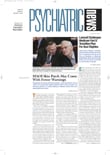According to the National Comorbidity Survey conducted in the 1990s, young adults used to have the largest lifetime risk of major depression. Now it is middle-aged adults, suggests a new study on the prevalence of major depression among Americans.
Lead author Deborah Hasin, Ph.D., a professor of clinical public health at Columbia University, published the results in the October Archives of General Psychiatry.
Although the reason for this finding is not certain, Hasin said in an interview, she suspects that it may reflect depressed baby boomers moving into middle age—“the same age cohort reflecting their increased risk as they march through the decades.” She also added that she was not surprised by the finding, although she “found it very intriguing and important.”
Hasin's new study, in fact, appears to be the largest American study conducted on the subject of major depression. It was based on the 2001-2002 National Epidemiologic Survey of Alcoholism and Related Conditions, which conducted face-to-face interviews with some 43,000 Americans aged 18 and older from all 50 states. The interview format used to generate diagnoses was the National Institute on Alcohol Abuse and Alcoholism's Alcohol Use Disorder and Associated Disabilities Interview Schedule–DSM-IV Version.
In contrast, the three previous studies that provided information about major depression prevalence—the Epidemiologic Catchment Area study, National Comorbidity Survey, and National Comorbidity Survey-R—interviewed only 19,000, 5,900, and 5,600 Americans, respectively.
This new study also yields other potentially valuable findings regarding the prevalence of major depression:
•
Study results showed a 12-month major depression prevalence rate of 5 percent and a lifetime major depression prevalence rate of 13 percent. These results are not all that different from those of the National Comorbidity Survey and the National Comorbidity Survey-R, which were conducted from 1990-1992 and from 2001-2002, respectively. However, they are considerably higher than the findings produced by the Epidemiologic Catchment Area study in the 1980s, which yielded figures of 3 percent and 5 percent, respectively.“ The U.S. rates of major depressive disorder are clearly higher than they were in the 1980s,” the investigators wrote.
•
Even after sociodemographic factors were taken into consideration, both current (within the past 12 months) and lifetime major depression were found to be significantly linked with various anxiety disorders (especially generalized anxiety disorder); various personality disorders (especially avoidant and dependent personalities), and substance dependence.
•
Regarding substance dependence, people with a current major depression were twice as likely to have alcohol or nicotine dependence as those without a major depression and four times as likely to have a drug dependence. Data were similar for those with a lifetime history of a major depression. Why major depression showed a stronger relationship to drug dependence than to alcohol or nicotine dependence remains to be explained, the researchers said.
•
By comparison, only a weak relationship between major depression and substance abuse emerged. Hasin said that she considers this finding—“that major depression had a much stronger relationship to alcohol and drug dependence than to abuse”—one of the most important to come from the study, because it underscores that substance abuse and dependence are different entities.
•
Finally, whereas blacks, Hispanics, and Asians were found to be significantly less at risk of a major depression than whites were, Native Americans were found to be more at risk. This latter finding appears to contradict that of another recently published study that found Native Americans to have a lower lifetime risk of major depression (Psychiatric News, October 7). However, that study was quite different in design. It compared some 3,000 individuals from two American Indian tribes with members of the general American population surveyed in the National Comorbidity Survey.
The study was funded by the National Institute on Alcohol Abuse and Alcoholism and the National Institute on Drug Abuse.
Arch Gen Psychiatry 2005 62 1097
